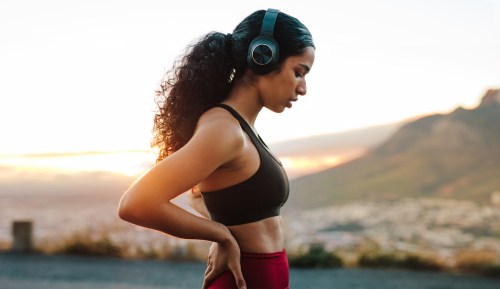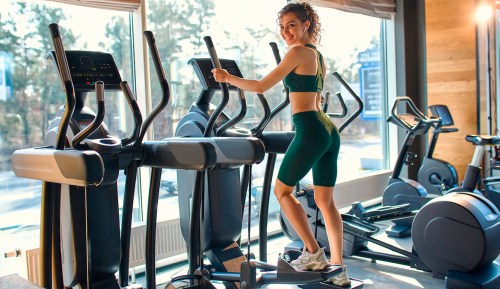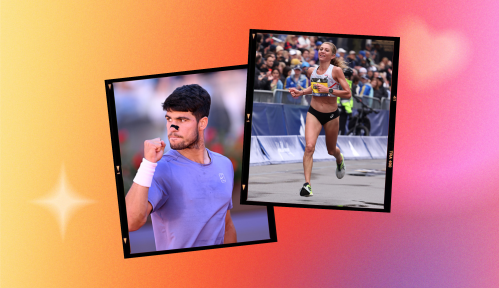How To Visualize Your Way to Your Next Fitness Goal, According to Experts
Improve your performance and get one step closer to reaching your fitness goals by implementing visualization into your routine.

We’ve all heard it, “If you can see it, you can be it.” Despite how much the taboo saying may put your teeth on edge, the practice behind the cliché is an instrumental technique that top athletes employ to strengthen their mental health and go after big dreams. Visualization, the practice of envisioning yourself going through the motions of an activity, has been proven to have a major positive impact on performance. The best part? It’s available to just about anyone and any goal.
Experts in This Article
Dylan Firsick, PhD, clinical assistant professor of psychiatry and behavioral sciences at the University of Southern California.
Eric Bean, PhD, CMPC, is an executive board member of the Association for Applied Sports Psychology.
Ryan Flaherty is the Senior Director of Performance at Nike.
“Visualization is one of the most powerful techniques for achieving optimal performance because it directly impacts our neurology that is essential for rapid, fluid execution of motor skills, managing emotions, and dealing with stress,” explains Eric Bean, PhD, CMPC, and executive board member of Association for Applied Sports Psychology.
Regardless, if you’re looking to jumpstart your workout routine or have your sights on something bigger, visualization—when implemented appropriately—can boost self-confidence, reduce anxiety, and help you feel prepared to navigate stressful scenarios, says Dr. Bean. To learn more about it, we talked with experts and badass athletes who regularly use the tool. Here’s what to know.
What is visualization, exactly?
“Visualization is a process by which we use all of our senses to generate a mental image to create or recreate an experience. In effect you’re incorporating all of your senses to mentally create or recreate an experience that triggers physiological reactions similar to actually experiencing the event,” says Dr. Bean.
Constructed of three main pillars: perspective, vividness, and controllability, visualization—and its big sibling, mindfulness—has been used by phenoms like Katie Ledecky, Venus Williams, and Simone Biles. The NBA, USA Swimming, and USA Gymnastics all offer mindfulness programs to their athletes and staff.
Why is visualization so popular among the best athletes in the world? During visualization, your brain taps the same neural pathways that are activated when performing a movement and during competition. “When imagining an experience, a person stimulates the same neural patterns of the actual experience,” says Dr. Bean. Say you visualize yourself doing a squat, he says, when you go through the motion in your mind, the same areas in your brain responsible for executing the movement pattern of a squat are engaged.
“In essence, we get a mental rep without further exhausting the muscles,” continues Dr. Bean. More practice with no physical strain? That’s a major win.
When you practice visualization, the brain goes into overdrive, especially when you fold in as many details—and senses—about the event as possible. “The fascinating part is if we make the visualization vivid, we can actually get more areas of the brain to light up during the visualization,” says Dylan Firsick, PhD, clinical assistant professor of psychiatry and behavioral sciences at the University of Southern California who helped to lead the 2017 NCAA Innovations and Practice Grant-winning Student-Athlete Mindfulness Program at the university.
The more senses you can engage, the better, he says. That means imagining what you might smell during the event, how equipment might feel in your hand or on your feet, and any sounds you might hear. It might also help to check out the facilities, race map, or any other details you can gather to include in the visualization.
For fitness goals, Dr. Bean recommends using what’s called an external perspective. “External perspective can be from the third-person perspective, where an individual imagines watching another person perform; or it can be from the second-person perspective where a person imagines watching their own performance as though reviewing a video of the performance. Visualization from the external perspective is particularly beneficial in performance where physical form and alignment is crucial—such as diving, gymnastics, skating, and dance,” says Dr. Bean.
Both Dr. Firsick and Dr. Bean underscore that it’s important to focus on positive outcomes during the visualization. This is where the third pillar—controllability—comes in. “If a person has difficulty imagining successfully performing a task, odds are that they will struggle with the actual performance of that task,” says Dr. Bean. Controllability encompasses not only how you’ll physically perform the skill, but how you’ll feel doing it. This is why mindfulness—the awareness of your thoughts—is key to productively using visualization.
Who is visualization right for?
Visualization can improve pretty much anyone’s performance. But you might find visualization particularly useful if you suffer from race-day jitters or tend to get daunted before tough workouts.
It can also help to quell anxious thoughts or depression. In a 2014 survey conducted among USC student-athletes, 56 percent shared that they experienced deep anxiety, nearly 33 percent of respondents battled depression, and over six percent had seriously considered suicide. Following the 2017 Student-Athlete Mindfulness Program, participants reported a “significant decline in anxiety, increased overall well-being, and improved mindfulness by the fifth [mindfulness] session,” according to the same survey results. After the completion of the program, 89 percent of participants continued to apply mindfulness to their respective sports.
“Visualizing yourself responding in a constructive way to stressful situations can help athletes regulate the anxiety they feel in games,” says Dr. Bean. When you visualize, you’re not only combatting a fear of failure, you’re developing self-confidence, Dr. Firsick echoes. That said, visualization shouldn’t take the place of other forms of help like talking with a certified therapist.
How to start a visualization practice
1. Start simple
https://www.instagram.com/p/B5s5H4zAgbF/
For Jo Anna Mixpe Ley, English teacher, community organizer, artist, and co-founder of Los Angeles-based running group, Running Mamis, visualization was something learned from her elders and has been used in a variety of facets of her life. “Visualization for me begins with an intention. It is a gift of ancestral knowledge via practice that I learned from my Indigenous elders,” she says. “Initially this was more of a practice in my day-to-day life when organizing with the community or for ceremonies.”
In fact, that’s not a bad way to start, says Dr. Bean. “The first step to integrating visualization is to start with something simple and familiar,” he says. But before you start visualizing, you might want to take a step back and first develop a mindfulness practice.
2. Build a mindfulness or breathwork foundation
“Before visualization, start on mindfulness or just on breathing,” says Dr. Firsick. “Give yourself some time, it doesn’t have to be a lot of time, it can be three or five minutes a day, but give yourself some time to learn how to breathe, how to relax, and how to practice mindfulness.” With mindfulness, you’ll be able to tap into your breath and remain focused on the task at hand, which might be logging a long run—or just visualizing it.
When you first start a mindfulness or visualization practice, Dr. Firsick emphasizes that consistency is key. Instead of trying to “crush” a single visualization or mindfulness session, bite off short pieces of time throughout the day to strengthen the skill, he recommends.
https://www.instagram.com/p/CPHbdNEHdqA/
Mireille Siné, MPH, a USATF Level 1 run coach who’s raced her share of marathons and ultra-marathons came to visualization through her mediation practice. “When I started meditating, I had recently run my first marathon and was starting to train for my second. I wanted to take what I learned during my first marathon and see how I could improve. I used visualization to imagine how I would feel during certain parts of the race, it was pretty much a part of my training strategy,” she says. By folding mindfulness and visualization into a workout routine, the practice will increasingly become enriched and more accessible—just like any part of a fitness program.
How to use visualization to reach your goal
Got a goal? Familiar with mindfulness? Great, you’re ready to start visualizing. Ultimately, finding the right method, perspective, and timing is totally up to you. To get started, try these steps to begin to fold in the technique to help you achieve whatever you’re eyeing.
1. Get comfortable practicing mindfulness
Harkening back to what Dr. Farsick said, laying the groundwork of a consistent mindfulness practice is key to develop visualization skills. “A most basic mindfulness foundation includes learning to bring in the breath, so your brain and body get oxygen, and then learn to use the breath to relax your body, mind, and muscles while remaining present-focused,” he says.
To do so, he suggests practicing mindfulness or breathwork three times a week for just three minutes per session until you can hold these sessions with minimal distraction. Once you feel comfortable with those skills, you can begin to focus on visualization. “For performance, it all comes down to breath. Slow your mind, relax your muscles, and get comfortable with [visualization],” he continues. “Give time before your workout to begin to incorporate visualization.”
If you’re looking for a little more guidance as you get more familiar with the practice, Dr. Firsick recommends downloading a mindfulness or meditation app like Headspace or Simple Habit. Alternatively, the Nike Run Club app includes a “Mindful Running” section that features narrated runs that emphasize the practice while you’re on the road. Meanwhile, Equinox+ offers to its members, Headstrong, a collection of meditations and soundscapes to settle thoughts and release anxiety.
2. Drill into details
When you begin to work on visualization, be sure to be as detailed as possible in the imagery for optimal results. “Typically, the more senses that are experienced, the greater the vividness and realism,” says Dr. Bean. “Optimal visualization includes the visual and tactile experiences, sounds, smells, and emotions. Think of vividness as a high-definition, 3D TV that immerses you in the experience as opposed to an old black-and-white TV with fuzzy images.”
https://www.instagram.com/p/CJmwUmyHWPV/
Siné does just this. “I pump myself up by reviewing what’s required in the workout or looking at the map of the race,” she explains. “I find that being as prepared as I possibly can helps to increase the potency of my visualization technique. After I’ve gathered as much detail as I can, I sit down and take myself through different points of the workout or race. I imagine what pace I will be running through certain sections, the moments when I’ll take in nutrition or a sip of water, even what I’ll do if I happen to see someone I know on the course.”
3. Talk to yourself
Ryan Flaherty, senior director of performance at Nike who’s worked with the likes of Serena Williams and others developed “The Athlete Mindset” after studying what made top pros stand out from the rest. The first part? An athlete’s self-talk. “The brain is interesting and has evolved over many years,” he says. “The brain tries to seek out problems around us. Champion athletes talk to themselves, they don’t listen to themselves.”
In addition to preparation, Siné uses positive affirmations during especially challenging portions of a race or course. “I can prepare my visualization of how I will overcome that rough patch and continue on with the race,” she says. “I may think of affirmations to go along with the practice such as ‘You got this’ or ‘One step at a time,’ while seeing myself simply putting one foot in front of the other.”
4. Squash negativity
Counterproductive thoughts happen, it’s what you do (or don’t do) with them that matters. If you find yourself in a spiral of negative thought, disrupt the dialogue. Dr. Firsick tasks athletes who are tough on themselves to first identify the negative thoughts (hi, mindfulness practice) and follow those thoughts with three unique positives that the athlete has previously articulated like how strong their work ethic is or that they’re particularly agile in a drill. If you experience something similar, try to follow any unproductive thoughts with something (big or small) that you did well during practice or the event itself.
https://www.instagram.com/p/CGA3dclA7x1/
Ley used this technique during an intense workout in sweltering heat as she prepared for The Speed Project (TSP) DIY (a new approach to the race during the pandemic in which athletes and teams logged as many miles possible during the current record it took past competitors to run from Santa Monica to Vegas).
“As I did my intervals, my legs felt heavier with each round. And all the doubt within me took over and I just let myself go and cried,” she recalls. “I allowed myself to be present in that moment and ride that emotion, but visualization helped me. I remembered that I wasn’t going to be running such long repetitive intervals during the actual TSP and although it was going to be hot, this training was going to enable me to pull that ancestral warrior strength within me. And that visualization really made all the difference.”
5. Practice patience
Like anything, it might take a little time to build vivid and successful visualizations. That’s okay—and more, totally normal. “[Visualization is] a muscle just like anything else,” says Dr. Firsick. “On the first day in a gym, you wouldn’t try to match people doing max-out or super heavy workouts. Don’t jump to long-length visualizations.”
“As with all skills, visualization takes practice,” reiterates Dr. Bean. “If you find yourself struggling, go back to something simple and familiar and slowly add in more difficult or complex elements.”
6. Try a beginner visualization exercise
Ready to embark on your visualization practice? Try this exercise courtesy of Dr. Bean:
“Visualize yourself walking around your home or apartment and then opening the refrigerator and pulling out a lemon. Then experience all of the steps and process to cut the lemon in half, then quarters, and then take a bite of a lemon wedge. This is a very common visualization exercise to practice integrating all of your senses from seeing your place, feeling the rind of the lemon as you cut it, to hearing the refrigerator open.”
No matter if you’re a newbie to mindfulness or visualization, a serious athlete looking to up your game, or someone interested in strengthening your mind-body connection, these tools can help you navigate your way to your goal. Get after it!
Oh hi! You look like someone who loves free workouts, discounts for cult-fave wellness brands, and exclusive Well+Good content. Sign up for Well+, our online community of wellness insiders, and unlock your rewards instantly.
Sign Up for Our Daily Newsletter
Get all the latest in wellness, trends, food, fitness, beauty, and more delivered right to your inbox.
Got it, you've been added to our email list.










